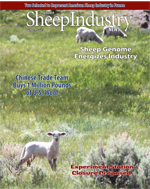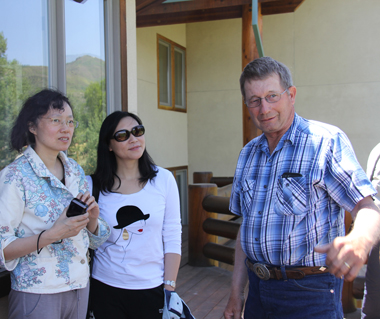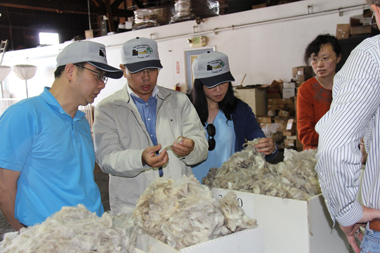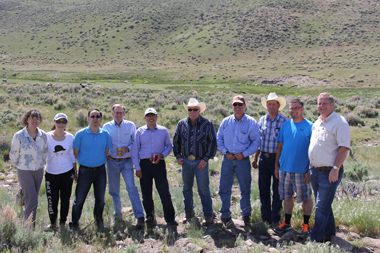
- July 2014
- President’s Notes
- Market Report
- ASI 150th Anniversary Blankets & Pillows Now Available
- Sheep Genome Excites Industry
- Closure of Sheep Experiment Station Proposed
- Industry News Briefs
- Support For Wildlife Services Moves Forward as Appropriations Vote Nears
- Chinese Buyers Get U.S. Wool Close-Up
- ASI Sending Pair of Young Shepherds to France to Compete in 2nd World Ovinpiades
- ASI Photo Contest Seeks Your Best Shots
Chinese Buyers Get U.S. Wool Close-Up
 Park City, UT.— Steve Osguthorpe’s guests didn’t have time to walk across the entirety of his family’s 178,000 acres. But the Utah sheep producer had little trouble leaving a lasting impression on wool buyers from three of China’s most prominent companies.
Park City, UT.— Steve Osguthorpe’s guests didn’t have time to walk across the entirety of his family’s 178,000 acres. But the Utah sheep producer had little trouble leaving a lasting impression on wool buyers from three of China’s most prominent companies.
“The family was very generous to us and their land is wonderful,” said Cindy Chan of Reward Wool Industry, one of the three buyers led by ASI on a 10-day trade visit to the United States that resulted in the purchase of more than 1 million pounds of U.S. wool.
ASI organized the visit by Chan, Zhongxian Zhu of Jiangsu Australia Harvest and Hua Zhou of Henghao Wool. The three buyers were escorted by ASI China representative Kitty Gu and ASI international marketing consultant Barry Savage on stops in Utah (Utah Wool Marketing Association), Texas (Anodyne) and Illinois (Groenwold).
In Utah, the group toured the Osguthorpe ranch and attended a cookout at the Osguthorpe family home that featured American lamb. The Osguthorpes raise sheep and cattle in and around Park City and in Delta, UT. They also lease about 1,000 acres of their land to the Canyons Ski Resort and operate a horseback riding and snowmobiling company.
“It was interesting to meet the Chinese buyers and hear their perspectives on the industry,” said Mike Osguthorpe, Steve’s son and a partner in the sheep operation. Mike a member of ASI’s Young Entrepreneurs Committee. “They were interested in seeing how our business works, so we were able to learn a bit about each other.”
The visit included a look at sheep belonging to David Cummings. Cummings grazes his sheep just outside of Park City.
“We enjoyed being able to able to see ewes and newborn lambs in their natural spring grazing,” said Zhongxian Zhu. “It gives an idea of where U.S. wool comes from, and how the process works in the U.S. All three buyers appreciated ASI’s role in arranging and helping fund the trip.”
Gu noted that Jiangsu Australia Harvest “is a Chinese company that typically purchases huge quantities of Australian wool each year. The company is the second-largest fleece top maker and direct wool consumer in China.”
“We are glad this company has started to purchase U.S. fine fleece,” she added.
Henghao Textile Co. Ltd., a large fleece wool user in China, was the only textile company who sponsored the Olympic games in Beijing.
“They tried a little U.S. wool before this trip, but wanted to know more about it, so they joined the trip and ordered a lot after collecting information,” said Gu. 

Reward Wool Industry, a re-known carbonized wool maker, typically imports only Australian carding types of wool and processes them into top quality products.
“After some facilitation, they tried the U.S. wool a little before this trip to the U.S.,” said Gu. “This company has strong capability to process carding types and regards U.S. wool as good potential for their future products from secondary to top end products.”
Following the visit, Gu said each of the three buyers had a positive experience. The only downside of the trip was that there was not more U.S. wool available.
“Though they ordered a million pounds of clean wool, they could order more if the U.S. could supply it,” said Gu. “But it’s good that ASI successfully developed the important buyers and have earned a good reputation with the Chinese buyers. The guests appreciate ASI’s great efforts and all suppliers’ hospitality.”
The Chinese market has been key to the U.S. wool industry for all types of wools over the past 14 years,” said Rita Kourlis Samuelson, ASI Wool Marketing Director. “We were fortunate to build this market at a time when the U.S. textile industry greatly reduced its capacity to buy U.S. wool. We also appreciate members of the U.S. wool industry for hosting the Chinese team and helping build the market in China.”


